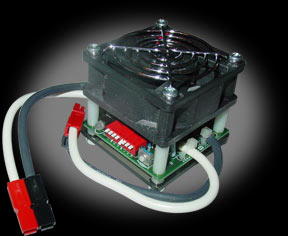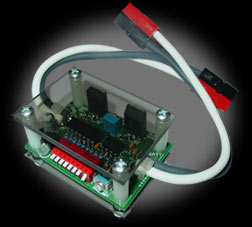Frequently Asked Questions (FAQ)
Is the ACM hardened for use in a fighting robot?
No. Although it is durable, it is not designed to handle the tremendous g-forces
it would experience during a fight.
Can I discharge more than one pack at a time with an ACM?
We don't recommend discharging NiCd or NiMH packs in parallel. Some users have
had no problem discharging multiple packs this way, but one or more cells
can potentially be damaged. You can use multiple loads without problems,
as long as the combined load currrent doesn't exceed the continuous discharge
current rating.
Can I discharge my 36V packs with an ACM?
Unfortunately, no. ACMs are rated for use with up to 24V (20-cell) packs, with
an absolute maximum of 35V. Do not use ACMs with battery packs containing
more than 20-cells. Even 24V (20-cell) packs can be at up to 32V or so immediately
after charging.
Can I use multiple ACMs to discharge one pack?
Yes. If you need to exceed a single ACM's continuous current or surge current
rating, you can parallel ACMs. Be sure that the loads on any one ACM do not
exceed its rating or the ACM will shut down to protect iteself before the
discharge is complete. During a discharge, one ACM may turn off a short time
before the other(s). This is normal and is due to the small differences in
the cutoff voltages between ACMs.
How much can I safely exceed the max. continuous current rating if
I'm not discharging for a long time, i.e., not continuously?
Officially, not one bit.
OK, with that out of the way, here's the scoop. The ACMs are conservatively
rated to ensure a long, trouble-free life. You can exceed the ratings, but
that can shorten the life of the ACM, perhaps considerably. Electronics hate
heat. Even though it's protected from over-temperature and over-current conditions,
repeatedly causing the ACM to shut down to protect itself can cause it to stay
at a very high temperature for long enough to damage the MOSFETs. This damage
is cumulative and can eventually cause the MOSFETs to fail. If you're discharging
3AH (or lesser capacity) battery packs, you can occasionally exceed the max.
continuous current rating of either ACM without problem. If the ACM turns off
before a discharge is complete, due to an over-current or over-temperature
condition, do not continue discharging at that rate! Please contact us about
your setup and we'll help you get the most out of your ACM.
 I accidentally shorted out the load connections (or exceeded the
max. surge or continuous current rating) during a discharge and I couldn't
restart the ACM. What's wrong?
I accidentally shorted out the load connections (or exceeded the
max. surge or continuous current rating) during a discharge and I couldn't
restart the ACM. What's wrong?
After a short-circuit, over-current, surge current, or over-temperature
(>175º C.)
condition, the ACM shuts down and needs to be reset before continuing the discharge.
This is done by by disconnecting the battery pack and load, making sure the
load is within the ACM's ratings and properly re-connected, and then reconnecting
the battery pack. You can now continue the discharge by pressing the Start
button again.
I
used several large motors (or bulbs) as a load for my ACM and
nothing happened (or I only get a "blip") when I pressed
the Start button. What's wrong?
The protection circuitry of the ACM will turn everything off within
microseconds if the surge current rating is exceeded. Motors and bulbs
have a very large starting current and several used together can exceed
the surge current ratings of the ACMs. To prevent this you can use
additional ACMs in parallel, fewer motors or bulbs, substitute a different
type of load, or use an inrush current limiter (ICL) to suppress these
large surge currents. We've successfully used the Thermometrics Model
CL-101 Inrush Current Limiter (16A max., steady-state), available from
DigiKey (part #KC024L-ND) and other sources. Be aware that ICLs can
get very hot, up to 175º C., during normal use. Before using this
ICL, or any other, be sure to download its data sheet and fully understand
how to properly and safely specify, install, and use an inrush current limiter
in your application. Do not use an ICL unless you've taken all proper precautions.
Why do I have to hold down the Start button for a couple of seconds
when using large incandescent bulb or motor loads?
The large starting (surge) currents that these loads draw when powered up can
cause the battery pack to drop below the cutoff voltage. The Auto-Cutoff Module
(ACM) senses this and turns off when you release the Start button. If you hold
down the Start button until the bulbs are at full brightness or the motors
are up to speed, the battery pack's voltage will rise back up and the ACM will
stay on when you release the button. If this doesn't work, and you're the battery
pack isn't already discharged, you'll need to reduce the load or add inrush
current limiters.